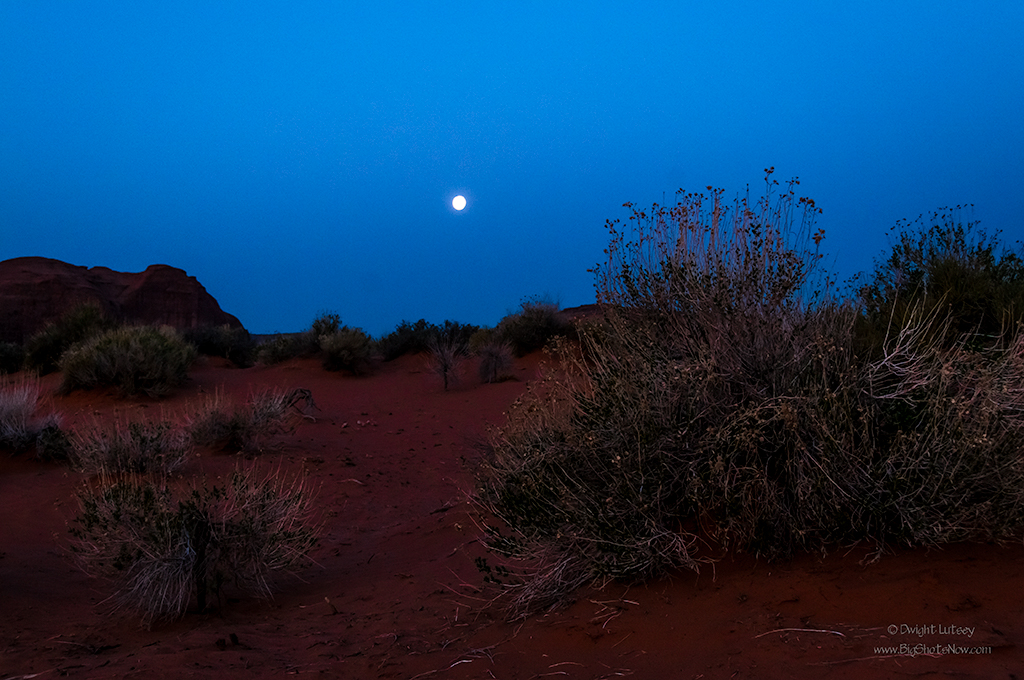This is Monument valley at 6 in the morning. It is cold here even though it is late April. You need a heavy coat and gloves and if you have a bald head like some of us you need a hat. Preferably one of those Russian kind made out of polar bear-wolf hybrids with ear flaps you can tie around your belt loops so the wind doesn’t blow it off. We didn’t need the tie downs this day as there was no wind. You also need lots of determination to stand out here waiting for the sun to come up.
It seems twice as cold as it is when you’re waiting. Stamping your feet helps some. Shivering is good. But what really saves the day is a hot thermos of strong black tea. No sugar, no milk, black as my last wife’s heart, as they say around the campfire at divorce school. That’s what gets you through the waiting, that and the thought of how gorgeous it’s going to be in a few minutes.
Everyone has seen pictures of Monument valley’s butte’s and spires, the colossal towers and the long views down the valley from John Ford’s point. They are the reasons many people come here, but there are other smaller views that are just as captivating. This one for instance.
Back behind the Totem pole and Yei Bi Chei is a place that is off-limits to visitors unless you have a guide. My guide whose Navajo name loosely translates to “Looks In My Wallet”, no I’m kidding, it actually means “Reaches Into My Wallet”, no, wait, I’m kidding again, it actually means Ed, brought me to a perfect spot to watch the sun come up behind the Totem pole. Behind where we had set up the camera gear was this dune and overhead our timekeeper the moon moving across the sky, clearing it of any obstacles that may hinder the sun’s passage. Ed said he liked this spot not only for the view of the sunrise, but if the wind was blowing which it does with startling frequency here in the valley, it was a protected place. The way he said it, in that low Indian voice made it sound much wiser than it really was. That’s one of the reasons you need a guide, you’d never figure that out on your own.
Ed was an interesting guy in his own right. He has been a stuntman in the movies, riding horses, falling off of them, “you don’t need much training for that ” he said, an extra in many of them, a guide around the valley and a sought after one at that, as he photographs the valley himself and knows all the good spots. He also tends to have a store of helpful tips for the visiting photographer. “When you fall and roll down the dune try not to get sand up your nose” was one of his favorites. “Don’t touch that it’s poisonous” was another. He said this even if what you were touching was actually poisonous or not. All in all he was a good guide and we weren’t lost for very long anyway. “An Adventure” he said, “to tell your grandchildren.” I don’t think we were lost, I just think he liked to see me carry 40 lbs. of gear through ankle-deep sand.
But the places we went were worth every moment of Ed’s wit. I remember this one the most because it seemed to be more about the desert than all the daytime shots of the monuments and far-reaching vistas put together. As there was no wind the silence was complete, except maybe for Ed’s wheezing, and the far off calling of a raven waking up, and the colors, the colors were something you had to experience. They began to form out of the darkness and became richer and more intense as the sky lightened. The deep nearly mahogany color of the sand against that impossibly blue sky. The yellow highlights on the Rabbit brush just becoming visible and of course the moon, impossibly white against the background of the heavens. This is why one becomes a photographer. For the image of course but also for the memories. And maybe for the chance of a brief visit with Ed. No, it’s the memories.


You must be logged in to post a comment.